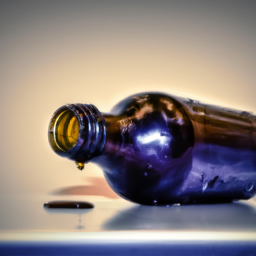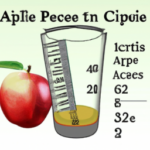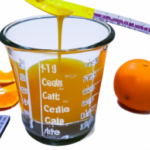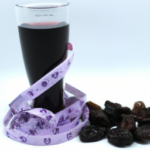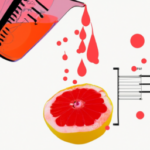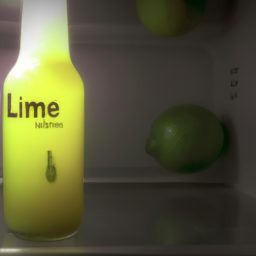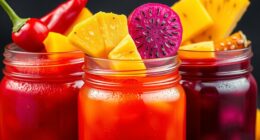As someone who is mindful of their health and always looking to improve their diet, I often think about the nutritional value of the food and beverages I consume. Apple juice is a beverage I enjoy regularly, but I have consistently wondered about its carbohydrate content.
Carbohydrates are an important nutrient that provide our bodies with energy, but too much of them can lead to weight gain and other health issues. So, how many carbs are in apple juice?
Before we dive into the specifics of apple juice, let’s first discuss what carbohydrates are and why they matter. Carbohydrates are one of the three main macronutrients (along with protein and fat) that our bodies need to function properly. They are found in a variety of foods, including fruits, vegetables, grains, and dairy products.
Carbohydrates are broken down into glucose, which is used by our cells as fuel. However, not all carbs are created equal, and some can have a negative impact on our health if consumed in excess. So, let’s explore how many carbs are in apple juice and what that means for our overall health.
Key Takeaways
- An 8 oz glass of apple juice contains 30g carbs, mostly from sugars, and is not a significant source of fiber or protein.
- Whole fruits are a better option for full nutritional benefits, but apple juice can still be a healthier option than many other sugary beverages.
- Other juices such as grape, orange, and pineapple juice contain similar or higher amounts of carbs.
- Low-carb alternatives like water, unsweetened tea, and vegetable juice are better options for those looking to limit their carb intake.
Understanding Carbohydrates
Carbs are often misunderstood, but they play a crucial role in providing energy to our bodies. There are three types of carbohydrates: sugars, starches, and fiber.
Sugars are the simplest form and found in fruits, vegetables, and milk. Starches are found in grains, potatoes, and legumes. Fiber is found in fruits, vegetables, and whole grains.
The glycemic index is a measure of how quickly carbohydrates are absorbed into the bloodstream. Foods with a high glycemic index, such as white bread and candy, are quickly absorbed and can cause spikes in blood sugar levels. Foods with a low glycemic index, such as whole grains and vegetables, are absorbed more slowly and provide sustained energy.
Understanding the different types of carbohydrates and their glycemic index can help us make informed choices about what we eat.
When it comes to apple juice, its carbohydrate content varies depending on whether it is freshly squeezed or store-bought. Freshly squeezed apple juice contains natural sugars and fiber from the apples, while store-bought apple juice may contain added sugars and have less fiber.
It’s important to read the label and choose apple juice that is low in added sugars and high in fiber for maximum nutritional benefits.
Carbohydrate Content in Apple Juice
The amount of natural sugars in a glass of apple juice may surprise you, as it contains about the same amount as a can of soda. Apple juice processing involves crushing the apples, extracting the juice, and then filtering and pasteurizing it to remove any bacteria or pathogens, but this processing also removes the fiber and some of the nutrients that are found in whole apples. This leaves behind a concentrated source of natural sugars.
On average, an 8-ounce glass of apple juice contains around 30 grams of carbohydrates, with most of it coming from sugars. This high sugar content in apple juice has been a topic of concern, especially for those who are watching their sugar intake or have diabetes. It’s important to note that while apple juice does contain some essential vitamins and minerals, it is not a significant source of fiber or protein.
With that said, it’s always best to consume whole fruits instead of juice to reap the full nutritional benefits.
When it comes to the nutritional value of apple juice, there is more to consider beyond just its carbohydrate content.
Nutritional Value of Apple Juice
When looking at the nutritional value, it’s important to consider more than just the sugar content in a glass of apple juice. The taste of apple juice and the different types of apples used in juice production can also impact its overall nutritional value. Here are some things to keep in mind:
-
Apples used in juice production can vary in their nutritional content, depending on factors such as where they were grown and how they were processed.
-
Apple juice is a good source of vitamin C, with one cup providing about 24% of the recommended daily intake.
-
Despite its sugar content, apple juice can still be a healthier option than many other sugary beverages, as it contains no added sugars and is naturally low in sodium and fat.
-
Drinking apple juice in moderation can have health benefits, such as reducing the risk of heart disease and certain types of cancer.
-
However, it’s important to remember that apple juice should not be a substitute for whole fruits, as it lacks the fiber and other nutrients found in the whole fruit.
As we move into comparing carbs in other juices, it’s important to keep in mind the unique nutritional value of apple juice and how it fits into a balanced diet.
Comparing Carbs in Other Juices
As we delve into the sugar content of other fruit juices, it’s important to remember that not all that glitters is gold. Comparing juice compositions can be tricky, as they vary greatly depending on the type of fruit used and the way it is processed.
For instance, while apple juice has around 24 grams of carbs per cup, grape juice has approximately 36 grams, and orange juice boasts 26 grams. Juice comparisons also reveal how carb content can vary within the same fruit.
For instance, while a cup of fresh-squeezed orange juice has 26 grams of carbs, a cup of canned orange juice has around 33 grams. Similarly, a cup of pineapple juice contains around 32 grams of carbs, while the same amount of canned pineapple juice contains approximately 42 grams.
These variations highlight the importance of reading labels and understanding how different processing methods can impact the nutritional value of the juice. With this in mind, let’s move on to comparing carbs in other beverages.
Comparing Carbs in Other Beverages
Don’t overlook the carb content in other beverages, as it can have a significant caloric impact and varying sugar content. For instance, a 12-ounce can of regular soda can contain around 39 grams of sugar, which is equivalent to 10 teaspoons. This amount of sugar can cause a spike in blood sugar levels, leading to a sugar rush followed by a crash, leaving one feeling fatigued and sluggish.
On the other hand, some beverages like unsweetened tea, coffee, and water have little or no carbs, making them an excellent choice for those watching their carb intake. However, it’s important to note that some drinks, like fruit juices and smoothies, can contain a high amount of carbs and sugar, despite being marketed as healthy options.
Understanding the carb content of different beverages can help individuals make informed decisions about their diet and reduce the risk of health problems associated with excessive sugar intake.
Moving on to the effects of carbs on health, it’s important to understand how carb intake affects the body’s energy levels and overall health.
Effects of Carbs on Health
Understanding how carbohydrate intake impacts overall health is crucial, as it can affect energy levels and contribute to various health issues.
Sugar intake, in particular, has been linked to an increased risk of obesity, type 2 diabetes, and heart disease. When we consume foods high in sugar, our body produces insulin to regulate our blood sugar levels. Over time, however, excessive sugar intake can lead to insulin resistance, which means our body becomes less responsive to insulin and has trouble regulating blood sugar levels. This can ultimately lead to a host of health problems.
To avoid the negative effects of excessive carbohydrate intake, it’s important to be mindful of the types and amounts of carbohydrates we consume.
Some low-carb alternatives to apple juice, for example, include water, unsweetened tea, or vegetable juice. By opting for these alternatives, we can still stay hydrated and get the nutrients we need without consuming excessive amounts of sugar.
Low-Carb Alternatives to Apple Juice
Looking for healthier options? You’ll love these low-carb alternatives to quench your thirst!
When it comes to fruit juices, apple juice is known to be high in carbohydrates. If you’re looking for low carb fruit options, consider trying unsweetened cranberry juice, lemon juice, or grapefruit juice. These options contain fewer carbs per serving, making them a great alternative to apple juice.
Another great option is sugar-free juice brands. These brands offer a variety of flavors without the added sugar and carbs found in traditional fruit juices. Look for brands such as Ocean Spray’s Diet Cranberry Juice or Simply Light Orange Juice. These options are perfect for those looking to reduce their carb intake without sacrificing taste.
Now that you know about these low-carb alternatives, let’s talk about portion control and moderation.
Portion Control and Moderation
It’s important to be mindful of how much juice you consume and to enjoy it in moderation if you want to maintain a balanced and healthy diet. Juice can be a great source of vitamins and nutrients, but it can also be high in sugar and calories. Portion control and moderation are key when it comes to incorporating juice into your diet.
To help with portion control, try measuring out your juice before drinking it. Use a small glass or cup, and stick to the recommended serving size on the label. It’s also a good idea to limit your juice intake to one serving per day and to drink it with a meal or snack to help balance out its effects on your blood sugar. Additionally, consider diluting your juice with water to reduce its sugar content and make it more hydrating.
| Portion Control Tips | Moderation Strategies | Healthy Juice Options |
|---|---|---|
| Measure out your juice | Limit juice intake to one serving per day | Look for 100% fruit juice |
| Use a small glass or cup | Drink juice with a meal or snack | Choose juice with no added sugars |
| Stick to recommended serving size | Dilute juice with water to reduce sugar content | Opt for fresh or homemade juice |
By incorporating portion control and moderation strategies, you can still enjoy the benefits of juice without overdoing it on sugar and calories. In the next section, we’ll explore some tips for choosing healthy juice options.
Tips for Choosing Healthy Juice Options
When I’m choosing juice, I always make sure to read the labels carefully. This helps me understand exactly what I’m putting into my body, especially when it comes to sugar content.
Additionally, I try to choose natural or low-sugar options whenever possible to ensure that I’m getting the most nutrients without overloading on sugar.
These simple tips have helped me make healthier choices when it comes to juice consumption.
Reading Labels
As you scan the label, your eyes widen in surprise as the sugar content of the apple juice jumps out at you like a neon sign. Interpreting labels is an essential skill when it comes to making healthy juice choices.
Reading the nutrition facts label can help you determine the sugar intake and other vital information about the drink you’re about to consume. The first thing to look for is the serving size. Many juice bottles contain multiple servings, which means you need to multiply the sugar content by the number of servings to get an accurate picture of what you’re consuming.
Next, check the grams of sugar per serving. The American Heart Association recommends that women should consume no more than 6 teaspoons (25 grams) of sugar per day, and men should consume no more than 9 teaspoons (37.5 grams) per day. If a single serving of apple juice contains more than 25 grams of sugar, it may be best to choose a natural or low-sugar option.
Choosing natural or low-sugar options can help you maintain a healthy diet without sacrificing taste.
Choosing Natural or Low-Sugar Options
To make a healthier choice, opt for beverages with lower sugar content and more natural ingredients to better maintain a balanced diet. When it comes to apple juice, it’s important to consider whether you’re choosing a natural or processed option.
Natural apple juice is made from fresh apples that have been juiced, while processed apple juice may contain added sugars, preservatives, and other ingredients. Here are some tips for choosing natural or low-sugar apple juice options:
-
Look for 100% apple juice: This means that the juice is made solely from apples, without any added sugars or preservatives.
-
Check the ingredients list: Avoid apple juice that contains high fructose corn syrup, artificial sweeteners, or other additives.
-
Consider organic options: Organic apple juice is made from apples that have been grown without the use of synthetic pesticides and fertilizers.
-
Dilute your juice: If you find that even natural apple juice contains too much sugar for your liking, try diluting it with water or sparkling water.
-
Try making your own: If you have access to fresh apples, consider making your own apple juice at home to ensure that it contains only natural ingredients and the desired level of sweetness.
Frequently Asked Questions
Can apple juice be a good source of carbohydrates for athletes?
Apple juice is an excellent source of carbohydrates for athletes, providing a quick boost of energy and aiding in muscle glycogen replenishment. It can significantly contribute to performance enhancement, making it a must-have for any athlete looking to excel. Plus, it tastes great too!
How does the carbohydrate content in apple juice compare to that of whole apples?
When comparing the carbohydrate content in apple juice and whole apples, apple juice has a higher concentration of carbs due to the removal of fiber. However, whole apples provide more nutritional value as they contain fiber and other essential vitamins and minerals.
Is there a difference in carbohydrate content between fresh and store-bought apple juice?
When comparing fresh and store-bought apple juice, there may be a difference in carbohydrate content due to added sugars or processing methods. Additionally, apple juice typically has less fiber and more sugar than apple sauce.
Can drinking too much apple juice lead to weight gain?
Drinking excessive amounts of apple juice can lead to weight gain due to its high sugar content. It can also increase the risk of insulin resistance and negatively impact dental health. Moderation is key.
Are there any health benefits to choosing low-carb alternatives to apple juice?
Choosing low carb options for juice can have nutritional benefits as they often contain fewer calories and less sugar. These options may also provide more vitamins and minerals per serving, making them a healthier choice overall.
Conclusion
Overall, understanding the amount of carbohydrates in apple juice is important for maintaining a healthy diet. While apple juice can be a tasty and convenient option, it’s important to be aware of its high carb content. It may be helpful to consider lower-carb alternatives such as water or unsweetened tea.
Moderation and portion control are crucial factors in maintaining a healthy lifestyle. Consuming apple juice in moderation can be a part of a healthy diet, but it’s important to consider the potential negative effects of excess carb consumption. High-carb diets have been linked to an increased risk of obesity, diabetes, and other health issues.
By being mindful of the amount of carbohydrates in our beverages and choosing lower-carb options, we can make small but impactful changes to improve our overall health and well-being.
Ilana has been a vegan for over 10 years. She originally made the switch for health reasons, but soon found herself becoming more and more passionate about the ethical and environmental implications of a vegan lifestyle. Ilana is the author of The Graceful Kitchen, a blog all about veganism. She loves to cook up delicious and nutritious vegan meals, and share her recipes with others who are interested in leading a cruelty-free life. Ilana is also a strong advocate for using whole foods as the foundation of a healthy diet, and believes that going vegan is one of the best ways to achieve this.

